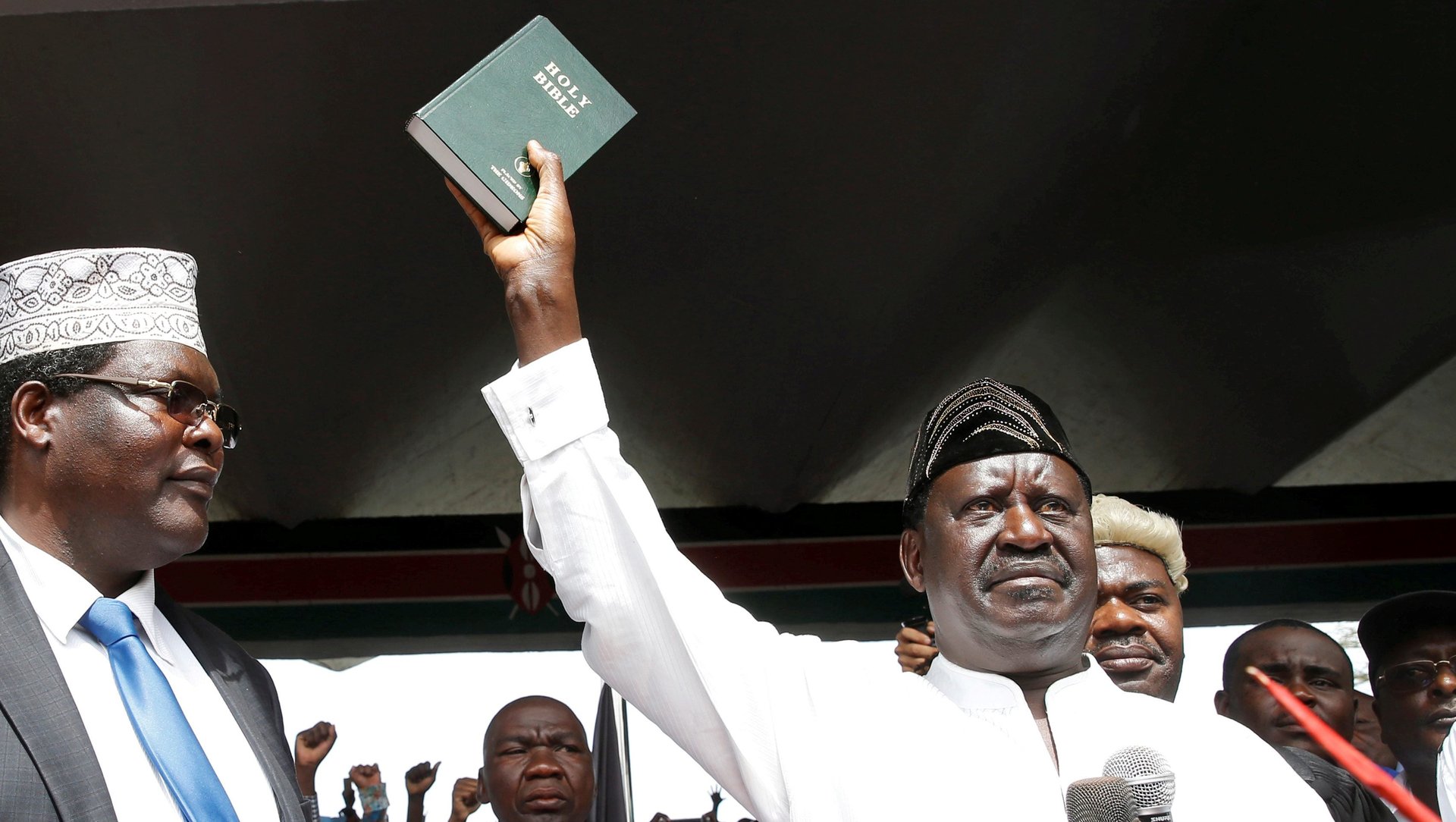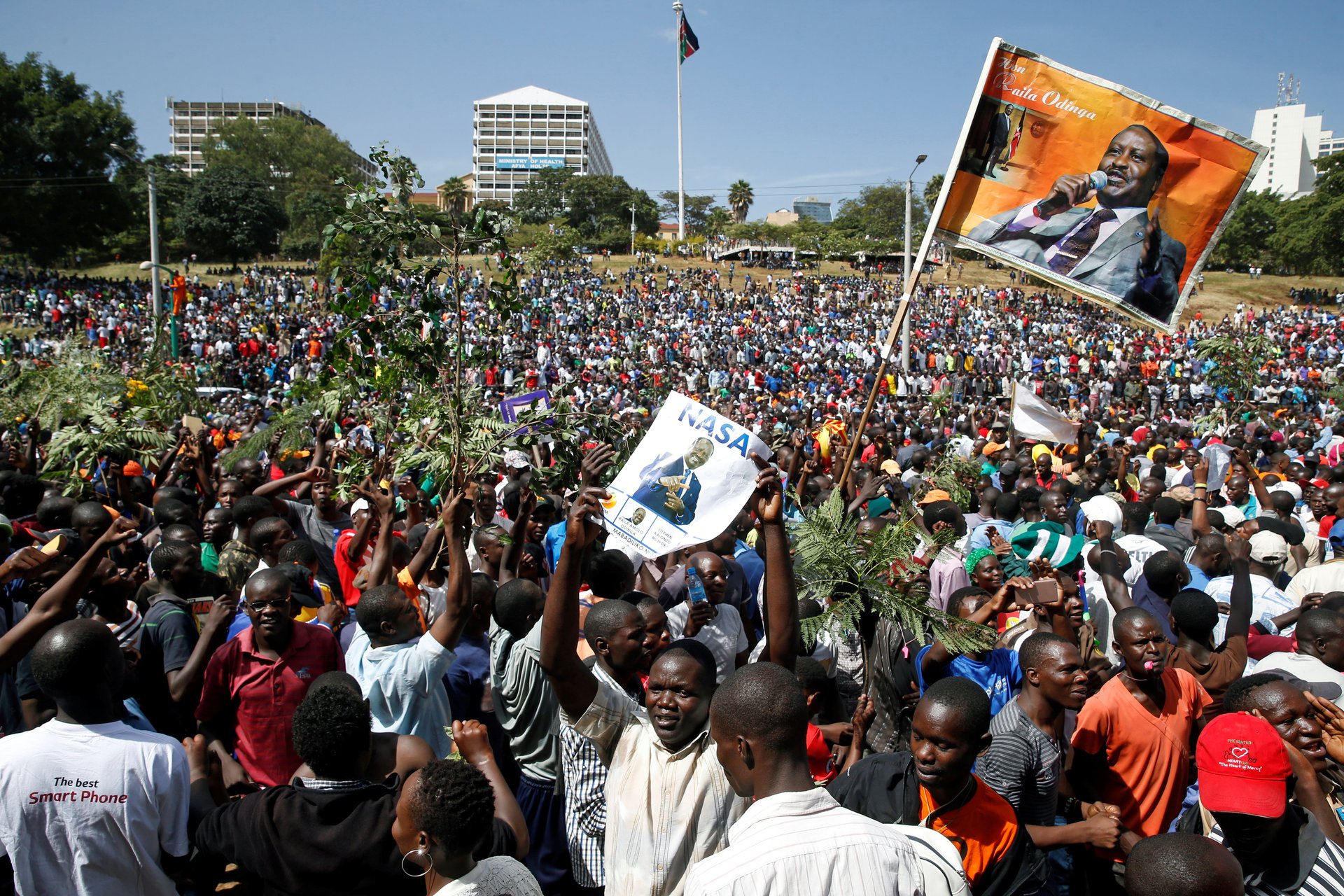Kenya’s opposition leader has been sworn in as the “people’s president”
Months after balking at the plan and raising doubts about whether it would make good on its promise, Kenya’s opposition coalition has sworn in Raila Odinga as the “people’s president.”


Months after balking at the plan and raising doubts about whether it would make good on its promise, Kenya’s opposition coalition has sworn in Raila Odinga as the “people’s president.”
His deputy, Kalonzo Musyoka, was not with him, but Odinga said he will be sworn in later.
Odinga quit the repeat presidential polls in October of 2017, saying the election wouldn’t be free and fair and accusing the government of using its majority in both houses of parliament to orchestrate a win. Following the boycott, president Uhuru Kenyatta was declared the winner, with over 98% of the vote, granting him a second term in office. Odinga dismissed the election as a “sham” and a “meaningless exercise,” and called for the creation of a “people’s assembly” that will be responsible for an economic boycott, peaceful protests, and constitutional change. That assembly was set to swear him on Dec. 12, but the event never took place.
The swearing-in poses a constitutional crisis for Kenya and heightens the political impasse that has gripped the East African nation since August last year. Last week, the opposition National Super Alliance (NASA) released new results claiming that Odinga had won the original August elections, and will use those results as the basis to swear him in. The electoral commission has refuted those claims.
On Tuesday (Jan. 30), thousands of NASA supporters thronged the Uhuru Park in downtown Nairobi for the oath-taking ceremony. Even though the county government had initially declared the park a no-go zone, police were withdrawn hours before the oath. Opposition leaders also confirmed that their security details were withdrawn by the government ahead of the ceremony.
Over the past few weeks, Odinga assured his supporters that he was ready to deliver them to the promised land of Canaan, the area in ancient Palestine that Israelites considered the biblical land God promised Abraham and his descendants—in this case symbolizing Kenya’s political journey since independence. He also said his life was not any more precious than the 92 or more people who died during the protracted and divisive election season.
“If it will cost me my life or send me to jail for life, I am ready for it,” Odinga said.
A sense of confusion and litany of fake news stories has surrounded the legality of the swearing in. In mid-January, attorney general Githu Muigai filed a High Court petition seeking to block the opposition from swearing in Raila Odinga. A fake letter started circulating online, purporting to be from chief justice David Maraga, cautioning judges against participating in Odinga’s oath. Maraga said he didn’t send the letter, and in any case had no legal mandate to direct any judge or magistrate on any matter.

Ahead of the swearing-in ceremony, the Communications Authority switched off the country’s top private television stations, without giving any information or a reason. Royal Media Services confirmed that Citizen Television, Radio ,and Inooro TV were off the air.
Reporters and editors at the Nation TV and Kenya Television Network also confirmed to Quartz that they were switched off on free-to-air platforms. Many linked the block to an alleged meeting that took place in the president’s office which was attended by media managers and select editors from the main media houses. According to the chairman of the Kenya Editors Guild Linus Kakai, the president “expressly threatened to shut down and revoke the licenses of any media house that would broadcast live the planned purported swearing in of NASA leaders.”
Odinga and NASA have refused calls from both local and international leaders to cancel the ceremony. Last week, the United Nations sent former Nigerian President Olusegun Obasanjo to broker a deal between Odinga and Kenyatta.
Asked how Kenya will be run with two presidents, NASA’s chief executive officer Norman Magaya was unequivocal: “Kenya will not have two presidents,” he said. “There has only been an imposter.”